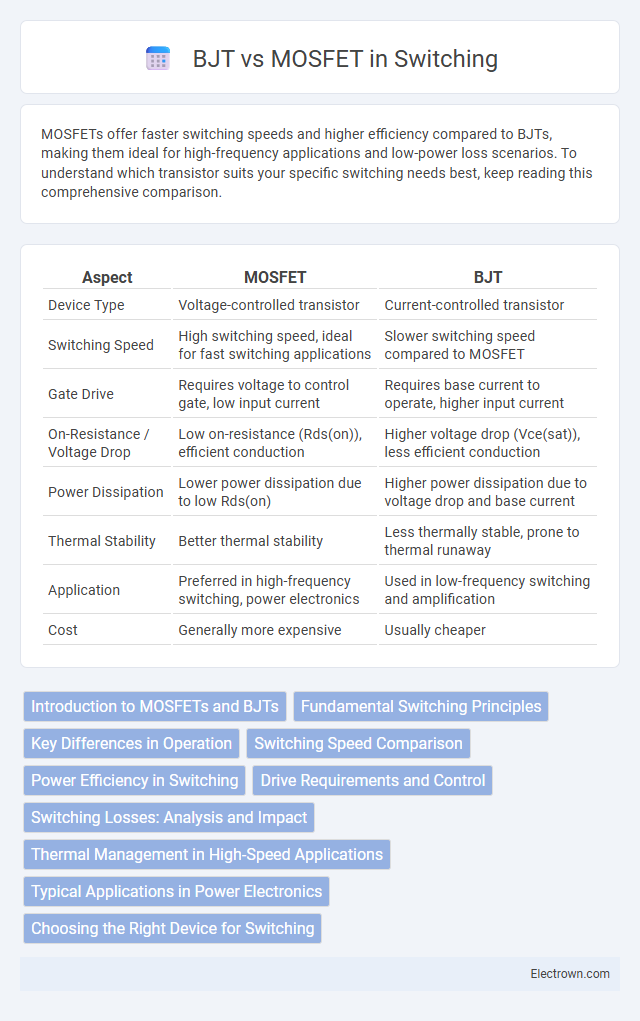MOSFETs offer faster switching speeds and higher efficiency compared to BJTs, making them ideal for high-frequency applications and low-power loss scenarios. To understand which transistor suits your specific switching needs best, keep reading this comprehensive comparison.
Table of Comparison
| Aspect | MOSFET | BJT |
|---|---|---|
| Device Type | Voltage-controlled transistor | Current-controlled transistor |
| Switching Speed | High switching speed, ideal for fast switching applications | Slower switching speed compared to MOSFET |
| Gate Drive | Requires voltage to control gate, low input current | Requires base current to operate, higher input current |
| On-Resistance / Voltage Drop | Low on-resistance (Rds(on)), efficient conduction | Higher voltage drop (Vce(sat)), less efficient conduction |
| Power Dissipation | Lower power dissipation due to low Rds(on) | Higher power dissipation due to voltage drop and base current |
| Thermal Stability | Better thermal stability | Less thermally stable, prone to thermal runaway |
| Application | Preferred in high-frequency switching, power electronics | Used in low-frequency switching and amplification |
| Cost | Generally more expensive | Usually cheaper |
Introduction to MOSFETs and BJTs
MOSFETs (Metal-Oxide-Semiconductor Field-Effect Transistors) are voltage-controlled devices widely used for high-speed switching applications due to their high input impedance and fast switching capabilities. BJTs (Bipolar Junction Transistors) operate as current-controlled devices, relying on minority carrier injection, which results in slower switching speeds compared to MOSFETs. The intrinsic properties of MOSFETs make them favorable for low-power, high-efficiency switching circuits, while BJTs excel in applications requiring high gain and robust current handling.
Fundamental Switching Principles
MOSFETs operate as voltage-controlled devices with low gate drive power, enabling rapid switching due to their majority carrier conduction and high input impedance. BJTs function as current-controlled devices, requiring continuous base current for conduction, which can result in slower switching speeds and higher switching losses. The inherent structure of MOSFETs allows for faster turn-on and turn-off times, making them more efficient for high-frequency switching applications compared to BJTs.
Key Differences in Operation
MOSFETs control switching through voltage applied at the gate, enabling fast switching speeds and high input impedance, which minimizes power loss. BJTs rely on current at the base to regulate conductivity, resulting in higher power consumption during switching due to continuous base current flow. Your choice between MOSFET and BJT depends on the desired efficiency and switching speed for your application.
Switching Speed Comparison
MOSFETs exhibit significantly faster switching speeds than BJTs due to their majority carrier operation, reducing charge storage effects and enabling rapid transitions. Typical MOSFET switching times range from nanoseconds to microseconds, while BJTs often experience slower switching caused by minority carrier charge storage, resulting in longer turn-off delays. Consequently, MOSFETs are preferred in high-frequency switching applications such as DC-DC converters and RF amplifiers.
Power Efficiency in Switching
MOSFETs offer superior power efficiency in switching applications due to their low on-resistance (R_DS(on)), which minimizes conduction losses compared to BJTs. BJTs require continuous base current to stay in the on state, resulting in higher power dissipation, whereas MOSFETs are voltage-driven devices and consume minimal gate current. Your choice of MOSFET can improve overall circuit efficiency, especially in high-frequency switching environments where reduced switching losses are critical.
Drive Requirements and Control
MOSFETs require voltage-driven gate control with minimal input current, enabling faster switching speeds and reduced power consumption in high-frequency applications. BJTs demand continuous base current for operation, resulting in higher drive power and slower switching times compared to MOSFETs. The voltage-driven nature of MOSFETs simplifies interface with digital control circuits, enhancing efficiency in switching applications.
Switching Losses: Analysis and Impact
Switching losses in MOSFETs are typically lower than in BJTs due to MOSFETs' voltage-driven gate and faster switching speeds, which reduce transition times and energy dissipation. BJTs, relying on current-driven bases, experience higher switching losses caused by storage charge and slower turn-off times, resulting in increased power dissipation during switching events. Your choice between MOSFET and BJT in switching applications significantly impacts efficiency, as minimizing switching losses improves overall device performance and thermal management.
Thermal Management in High-Speed Applications
MOSFETs exhibit superior thermal characteristics in high-speed switching applications due to their low on-resistance (R_DS(on)), which minimizes conduction losses and reduces heat generation compared to BJTs. The unipolar conduction nature of MOSFETs results in faster switching transitions and less switching losses, enhancing overall thermal management efficiency under high-frequency operation. Effective heat dissipation techniques are critical for both devices, but MOSFETs typically require smaller heatsinks and simpler cooling solutions in high-speed environments owing to their improved thermal performance.
Typical Applications in Power Electronics
MOSFETs dominate switching roles in power electronics for applications requiring high-speed, high-efficiency operation such as DC-DC converters, motor drives, and switched-mode power supplies. BJTs find typical use in lower-frequency power switching, amplifiers, and linear regulator circuits where their higher current gain provides advantages. Your choice between MOSFET and BJT depends on the specific power, switching speed, and efficiency requirements of your electronic system.
Choosing the Right Device for Switching
Selecting the right device for switching hinges on key parameters such as switching speed, power efficiency, and gate drive requirements. MOSFETs provide superior switching speeds and lower gate drive power, making them ideal for high-frequency applications and low-voltage circuits. BJTs offer robust current handling and simple drive circuitry, which can be advantageous in medium-frequency, high-current switching scenarios.
mosfet vs bjt in switching Infographic

 electrown.com
electrown.com